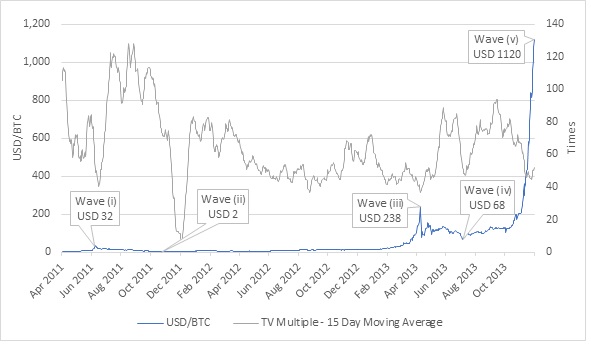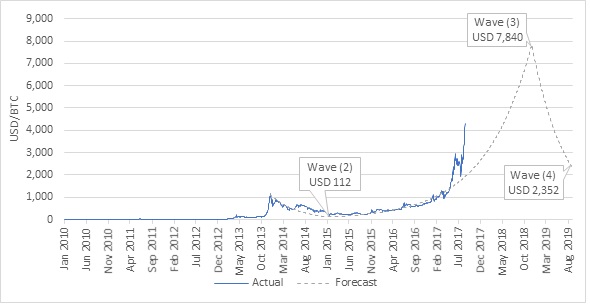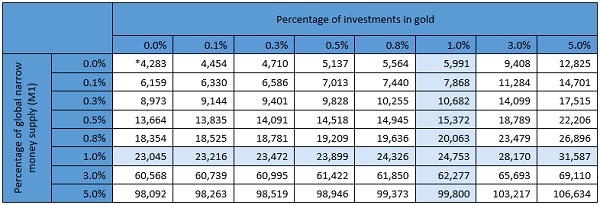Next Stop for Bitcoin Price: Onwards and Upwards?
|
Bitcoin was introduced in 2009, and its value has since grown exponentially. It reached parity with the US dollar (USD 1 = BTC 1) in early 2011. Today, a Bitcoin is worth USD 4,283 (as of 15 August 2017). |
|
Bitcoin’s price rose more than 300% YTD in 2017, while top altcoins such as Ethereum (up ~3,500%) and Ripple (up ~2,400%) bettered Bitcoin’s increase, overtaking more conventional asset classes with significant leads. The S&P 500 rose ~8% and gold ~11% as the US dollar fell ~9%. Meanwhile, concerns about a speculative crypto-bubble have already emerged. That said, altcoins are rapidly taking wealth away from Bitcoin. Bitcoin accounted for nearly 90% of the overall cryptocurrency market capitalisation in January 2017; by August 2017, this had fallen to ~50%. Bitcoin has a history of boom and bust cycles, with three notable peaks in its eight years of circulation (in June 2011, April 2013, and November 2013). Leading up to each of its past peaks, Bitcoin has traded at a transaction value (TV) multiple of ~50-70x, and this exceeded 100x in the post-boom periods, as high prices failed to justify an active transaction demand. In comparison, the average TV multiple YTD has been 62x, indicating that the recent surge in Bitcoin price is broadly supported by transactions. Quantifying Bitcoin’s intrinsic value continues to be a challenge. This makes speculation inevitable, and Bitcoin will consequently continue to experience boom and bust cycles. Our technical analysis indicates that Bitcoin could peak next at ~USD 7,800 by late 2018, before seeing a ~70% correction. |
|
Recent Bitcoin Rally Supported by Fundamentals Bitcoin has historically experienced boom and bust cycles mostly due to speculation. High Bitcoin prices during boom periods have often not been supported by active transaction demand, either to buy goods and services from merchants or to simply trade, and have eventually led to drastic declines in value. Transaction Value Multiple: PE Ratio for Bitcoin The transaction value (TV) multiple is the ratio of Bitcoin market capitalisation to its daily transaction value, i.e. the value of a Bitcoin for a dollar’s worth of transactions. The TV multiple is similar to the trailing PE ratio of a stock. The PE ratio reflects how much an investor is paying for a dollar of earnings, or, in a more economic sense, for a unit of utility (utility for a Bitcoin holder is engagement in transactions). Alternatively, the inverse of the TV multiple shows the percentage of total wealth in Bitcoin actively used in transactions.The Bitcoin TV multiple averaged ~80x over 2011-17, yet includes post-boom periods where the multiple was over 100x, where less than 1% of wealth was actively transacted. During the periods leading up to a boom, the TV multiple has averaged ~50x-70x. This implies that ~2% of value was transacted daily. Bitcoin had been trading at an average TV multiple of 68x leading up to the 2013/14 boom. It reached 196x in the post-boom period. By the time the TV multiple reached 100x, more than 33% of peak value was lost. On average, only ~0.8% of the overall wealth in Bitcoin was actively used for transactions during the declining phase. Eventually, Bitcoin fell ~90% from its peak level. However, during the recent rally in prices, TV multiples have been in the range of 40x-80x, averaging ~62x in 2017. This means that ~1.6% of the overall wealth in Bitcoin was actively used for transactions. Therefore, we believe that the recent surge in Bitcoin price is broadly supported by an active transaction demand, at least for now. TV Multiple Remains Stable Despite Recent Surge in Bitcoin Price
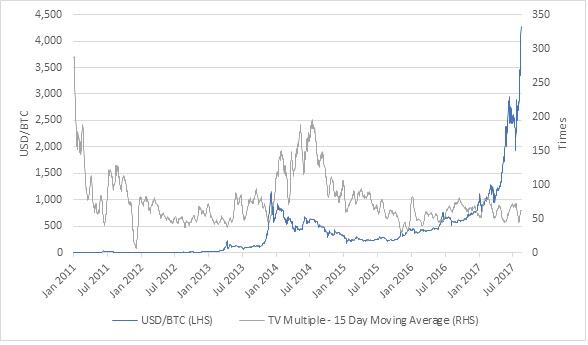 Source: Compiled by UZABASE based on information from blockchain.info
|
|
Bitcoin to Peak by Late Next Year Our technical analysis based on Elliot wave fractals indicates that Bitcoin could peak at ~USD 7,800 by November 2018, before seeing a ~70% correction. Elliot Wave Theory: Cycles Multiply as They Come The Elliot Wave Theory is based on the notion that cycles are repetitive, and short-run cycles are essentially fractals of long-run cycles. The theory proposes an eight long-run wave cycle, with five short-run waves (i, ii, iii, iv, and v) forming the long-run wave (1). As per the fractal relationship, a long-run wave is a multiple of its corresponding short-run wave. For example, short-run wave (i) is a multiple of the long-run wave (1), and short run wave (ii) is a multiple of the long-run wave (2), and so on. 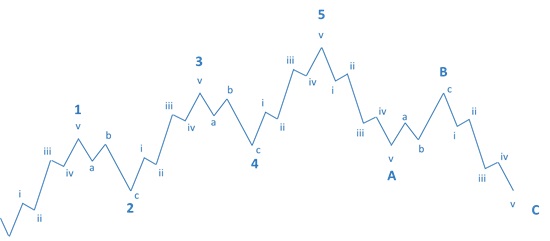 Source: UZABASE
In June 2011, Bitcoin peaked for the first time, reaching USD 32.0, up ~400x from January 2010 when it first started gathering momentum. We identify this period, from January 2010 to June 2011, as the first of our short-run impulse waves (wave i). This was followed by a correctional wave (wave ii), which saw Bitcoin’s value fall dramatically to USD 2.0 by October 2011, a ~90% decrease from its peak value. Bitcoin peaked again at USD 238.0 in April 2013, after a steady ~500-day rally (wave iii), only to fall ~70% to USD 68.0 by July 2013 (wave iv). Bitcoin rose once more to USD 1,120 in November 2013 (wave v), completing the first wave of the first long-run Bitcoin cycle (wave 1). Long-Run Wave (1): Breakdown
Impulse waves are highlighted in green and correction waves are highlighted in red
(1) Value multiple for impulse waves = value of the wave divided by value of wave (i), rounded off to the nearest whole number
(1) Value multiple for correction waves = 1 – (value of the wave divided by value of the preceding wave), rounded off to the nearest 0.1
(2) Time multiple = time taken for the wave divided by time taken for wave (i), rounded off to the nearest 50 days
Source: Compiled by UZABASE based on information from blockchain.info
Source: Compiled by UZABASE based on information from blockchain.info
Following the peak, Bitcoin value fell ~84% to USD 177.0 in January 2015 (wave 2). This was broadly in line with the fractal estimate of USD 112.0, a ~90% decline. Assuming the fractal relationship holds, Bitcoin could reach USD 7,840 by November 2018 (wave 3), before seeing a ~70% correction the following year (wave 4). Our wave 5 estimate puts Bitcoin closer to USD 40,000; however, we believe this figure is somewhat optimistic. An important point to note is that our analysis is based only on a single short-run wave, rather than on average fractal multiples of several short-run waves. Using a longer time period and multiple short-run waves should make the analysis more representative. Long-Run Cycle: Forecast
Impulse waves are highlighted in green and correction waves are highlighted in red. Over optimistic estimates are highlighted in grey
(1) Projected value = value of the wave (1) multiplied by value multiple of the respective short-run wave
(2) Projected time = time taken for wave (1) multiplied by time multiple of the respective short-run wave
Source: Compiled by UZABASE based on information from blockchain.info
Source: Compiled by UZABASE based on information from blockchain.info
The recent Bitcoin rally beats our mid-wave price consensus. We believe this is due to overexcitement about recent gains and SegWit adaptation (an upgrade to the Bitcoin network to fix transaction speeds by stripping out transaction data) in early August 2017, boosting confidence in Bitcoin, and is likely to correct towards the original trajectory. |
|
Sluggish Adaptation Inhibits Bitcoin’s Long-Run Potential After nearly eight years in circulation, there are less than 15 million Bitcoin users. While perfect comparisons are not possible in this context, compared with other digital adaptations in the new millennium, Bitcoin has made slow progress. In its first eight years, Facebook reached one billion active users, and Apple iPhone sold over 700 million units. However, it is unrealistic to expect a cryptocurrency to grow on the same trajectory as social media or smartphones. PayPal – an online payment system that serves as an alternative to traditional money – is perhaps a better comparable. That said, even PayPal reached nearly 57 million active users in its first eight years up to 2007, when the number of internet users worldwide was just over one billion, compared with nearly four billion today. One of the main arguments for low Bitcoin adaptation has been its low acceptance. Only a few retailers accept Bitcoin as a payment for goods and services, including just a handful of top retailers such as Dell, Microsoft, and Overstock, who moreover do so on limited items. This does not necessarily mean that Bitcoin is worthless as exchange, given that it led gift card providers such as Gyft and eGifter to provide the option of purchasing gift cards of all major retailers using Bitcoin. More merchants accepting Bitcoin would go a long way in boosting its adaptation. On the other hand, more consumers regularly making Bitcoin purchases could eventually push merchants to accept it. This is where we believe Bitcoin has faltered – in attracting a wider network of users willing to convert their money to Bitcoin for spending. In fact, as a medium of exchange, Bitcoin remains in its infancy. Global narrow money supply, i.e. the total liquid money in the world available for transactions, is ~USD 31 trillion (CIA Factbook, 2016). The current Bitcoin market capitalisation is USD 71.0 billion, only 0.2% of the global narrow money supply. Bitcoin is loosely considered an alternative to gold as a store of wealth. Bitcoin is rare and finite in supply – the very traits that have made gold a successful store of wealth over several centuries. Additionally, the fact that Bitcoin is independent of any monetary authority makes it an ideal safe haven, with less vulnerability to economic shocks. Nonetheless, high price volatility in the past have precluded Bitcoin from winning adequate confidence as a store of wealth. Currently, the Bitcoin market is worth only 2.0% of the ~USD 3.0 trillion total global investments in gold (World Gold Council, 2017). Bitcoin Mining: “Digging” the Internet Bitcoin, or for that matter any cryptocurrency, is based on the underlying blockchain technology. Blockchain is essentially a shared ledger that records how a single Bitcoin changed hands from the time it is mined. When a user requests for a Bitcoin transaction, it needs to be verified via blockchain. This verification process requires solving a complex algorithm, and this is done using computerised software. Miners are essentially solvers of these blockchain algorithms; when a miner cracks the algorithm and helps the user to carry out the transaction, the miner is awarded a fixed number of Bitcoin (at present, 25 coins per transaction).The number of Bitcoin that can ever be mined is capped at 21 million coins, and only 16 million of this is currently in circulation. The Bitcoin network is designed in a way that mining becomes tougher as supply reaches its cap value. At current estimates, the last Bitcoin will be mined only in 2041, making Bitcoin both rare and finite. In a highly optimistic world, we can assume Bitcoin attracts 1% of the global narrow money supply and wealth stored in gold. This would mean that wealth amounting to nearly USD 350 billion would move into Bitcoin, pushing its market capitalisation closer to USD 400 billion, while a single Bitcoin may be worth more than USD 20,000. However, critical to reaching such high values is Bitcoin’s widespread adaptation and acceptance, which, as of now, is considerably low. Scenario Analysis: Value of a Bitcoin if Wealth Moved from Liquid Money and Gold
*Current price as at 15 August 2017
Source: Compiled by UZABASE based on information from blockchain.com, CIA World Factbook, and World Gold Council |
|
Altcoins, the Biggest Bitcoin Value Destroyer Bitcoin came into existence in 2009 as the first of its kind. Several other cryptocurrencies (commonly known as altcoins) have since emerged, with Ethereum, Ripple, Litecoin, and Bitcoin Cash (the latest addition) being the most common. As these altcoins gather momentum, Bitcoin has seen a considerable deterioration in its supremacy. Strong altcoin performance in recent times, with Ethereum gaining ~3,500% and Ripple gaining ~2,400% YTD, is encouraging users to move wealth from Bitcoin to altcoins. In January 2017, Bitcoin accounted for nearly 90% of the overall cryptocurrency market capitalisation, but by August 2017, this had fallen to ~50%. However, most of these altcoin gains have been recent. During July 2014-16, in its first two years of circulation, Ethereum grew only ~38x, compared with Bitcoin’s ~199x growth in its first two years of circulation (August 2010-12). Bitcoin Market Share Declines Considerably in 2017
Source: Edited by UZABASE based on coinmarketcap.com
Top Altcoins Post Strong Price Performance YTD
Source: Compiled by UZABASE based on coinmarketcap.com
Bitcoin is also handicapped by technology. With the emergence of new altcoins with better security and transaction speed, Bitcoin users might shift to these “shinier” coins. An example of this was the Bitcoin hard fork in early August 2017, where the Bitcoin network split to make way for a new altcoin: Bitcoin Cash. Bitcoin Cash has the ability to process 8x more transactions per day than Bitcoin. Despite Bitcoin Cash not gaining its anticipated momentum (it fell ~40% since the fork), ~USD 5 billion in value moved out from Bitcoin as a result of the fork. On a separate note, we find it difficult to justify recent growth in cryptocurrency prices outside of Bitcoin as anything other than pure speculation. All top altcoins are up at least 800% YTD, and initial coin offerings (ICO) have exceeded USD 1.2 billion YTD, already surpassing what it raised for 2016. Although it is too early to recognise a crypto-bubble, the signs so far raise some red flags. This could go either way for Bitcoin. Bitcoin could easily get caught in the “cryptomania” and collapse; alternatively, altcoin holders might feel encouraged to shift to Bitcoin, considering it a stronger and stable option for cryptocurrency. |





